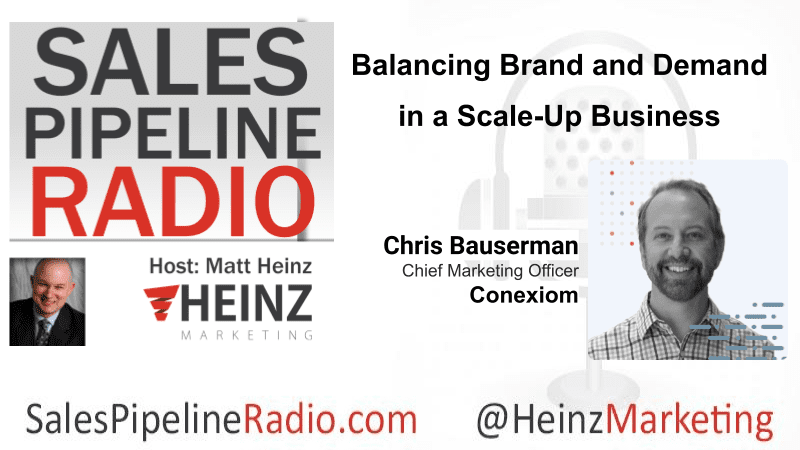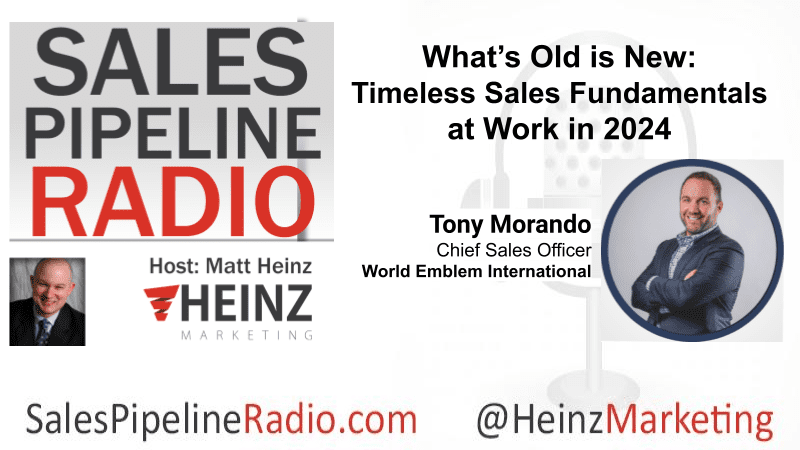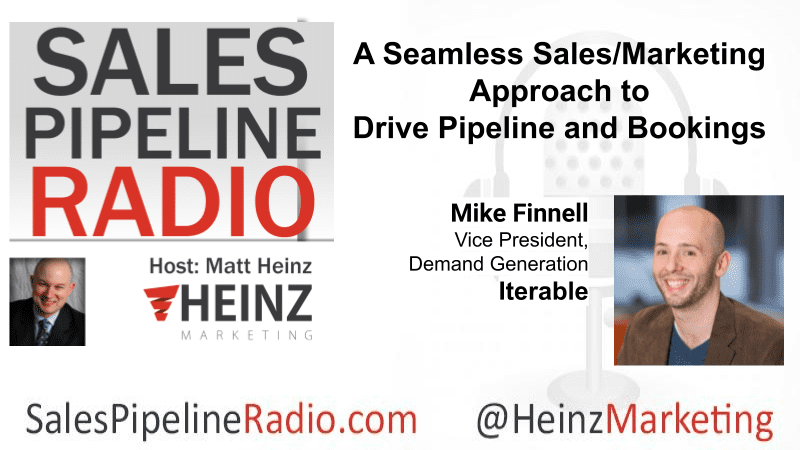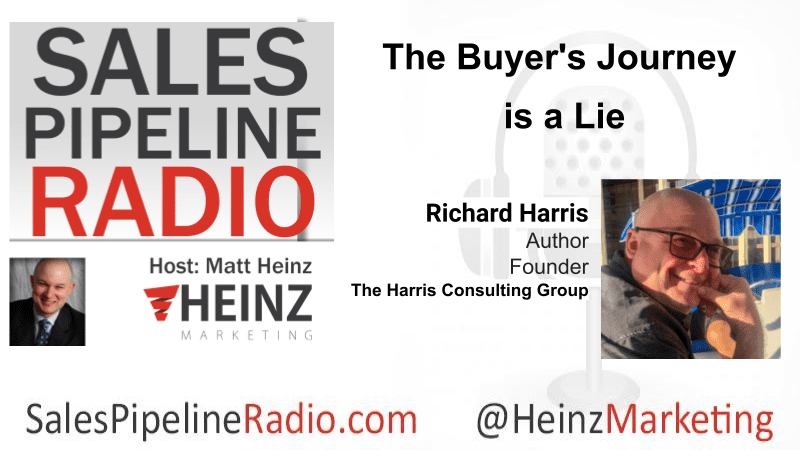Sales Pipeline Radio, Episode 358: Q & A with Chris Bauserman

Summary
Matt interviews the best and brightest minds in sales and Marketing on Sales Pipeline Radio.
By Matt Heinz, President of Heinz Marketing
If you’re not already subscribed to Sales Pipeline Radio or listening live Thursdays at 11:30 am PT on LinkedIn (also on demand) you can find the transcription and recording here on the blog every Monday morning. The show is less than 30 minutes, fast-paced and full of actionable advice, best practices and more for B2B sales and marketing professionals.
We cover a wide range of topics, with a focus on sales development and inside sales priorities.
This week’s show is entitled, “Balancing Brand and Demand in a Scale-Up Business“ and my guest is Chris Bauserman, CMO at Conexiom.
Tune in to Learn About:
- Creating Urgency in Marketing: Use strategies analogous to spearfishing and account-based marketing to generate urgency in the market.
- Foundations of Alignment: Rethink Ideal Customer Profiles (ICP) and analyze customer data to target high-value segments effectively.
- ROI and Decision-making: Understand acquisition costs and customer lifetime value to make informed business decisions aligned with corporate objectives.
Watch the video, listen in below and/or read the transcript below.
Matt: All right. Welcome everybody to another episode of Sales Pipeline Radio. I’m your host, Matt Heinz. So excited to have you here for another conversation about what’s working today in B2B sales and marketing, especially in those complex sales motions that could really use a little more predictability.
Thank you very much for, for being here. If you’re watching or listening on demand, thank you for downloading and subscribing every episode of Sales Pipeline Radio, always available at salespipelineradio.com. And today we’re going to do a little bit of a marketing therapy session with my friend, Chris Bauserman.
He’s the CMO at Conexiom and we’ve had a couple of conversations recently, Chris, just about just marketing best practices. And whenever we talk about marketing best practices today, we tend to get into sort of dumpster fire territory as well, because this is not easy. Talk about what I’ve sometimes heard described as complexity creep and how marketing gets done today.
I wish it wasn’t so, but to do marketing well requires a lot of layers of complexity that can be managed. So we’d love to have you share– you’re in the seat, man. So what are you seeing at Conexiom? What are some of the challenges that you hear from some of your other CMO peers as well?
Chris: Yeah. Hey, Matt, thanks for having me on. Always great to chat and to chat with fellow good market leaders out there about what’s, happening. It’s no surprise today, still seeing headwinds and just in terms of customers really wanting to spend, and really start off new initiatives beyond the top two or three.
Right. The biggest challenge we have is finding a great customer or prospects who, everything looks like it could be a great but I can only do three things this year and the plate’s already full.
So let’s talk later. So that’s the biggest challenge I think right now is creating that urgency in the market.
Matt: When I think about urgency, I think about the difference between manufacturing it and discovering it. Can you talk a little bit about that?
Chris: I think that manufacturer versus discover is spot on. And what we’ve talked about in the team this year is really tied to big goals and go to market. I’m not a big fisher, but the fishing analogy happened to work.
One is where you’re going to do much better at spearfishing and that’s really swarming and spending disproportionate amount of effort in marketing and sales on a customer showing any signals that might be buying, right. And it could be buying an alternative approach, but just In the market, this is one of those top priorities.
Let’s not treat them as equal opportunity. Let’s go at them hard. And the second one is that creation, right? Is that building it and that’s, called fatten the fish, right? And that’s kind of getting into your account-based marketing, your thought leadership, but again, really trying to dial in and say, Hey, we know these are the things that matter to you.
Let’s educate you on why the things that matter to you are important actually are helped by doing something that looks like, we can help with and let’s start those conversations early, meet them where they are in terms of their buying process, which is nothing right.
They’re problem aware though. Let’s meet them at that problem aware state and then really nurture them and work on those relationships to to find out the opportunity.
Matt: You start early, you educate, you build a relationship. These things take time, Chris, especially in a B2B sales, especially in a complex B2B sale.
We haven’t even talked about buying committees and multi-threading yet. We all have a number to hit. We’re all in a hurry to get those deals closed., you risk reward in terms of pushing them too quickly, where, you know, we know where they need to be, but they need to be committed to change first.
That creates tension in the organization as well, right? We need to take these steps to get someone ready to be successful. So we want to apply some polite persistence perhaps. But where do you find that balance? And what do you listen for with prospects that indicates some might be ready to move a little faster.
Chris: The listening is really important and it’s also really important to think about matching the conversation topic and the offer with the right level of organization. Right. And I think more so than ever with tight budgets, it’s important to find topics of conversation that get in the agenda of more senior leadership.
When you think about budget makers versus budget spenders. And so, in those tight environments, having those conversations with VPs, C level prospects, which can be really hard enterprises, but you’ve got to put that investment in, if that’s your target market, but getting in their conversations and finding out what’s on their agenda and how you can hook into that is important, right?
And then, you know, I’d much rather have a conversation with the CEO who says, yes, this would help in this part of the business and this part of the business. And I can see this has even more value than you’re talking about… challenges, the money might be a problem. My CIO is overburdened, let me talk to him. Let’s get back to you. That’s a conversation. Now you can say, Hey, the momentum is there. Then, then it’s like, how can we handle that objection? Right. Let’s, let’s talk about how we can do this without taking a ton of your CIO’s time, if that’s the bottleneck. So that’s probably the biggest thing.
We are in a situation now where because of XYZ acquisition we just did, there’s no way we can cut this till October. Then, that’s still a win, right? Cause you’ve kind of created that, nurture them and then make sure you re engage in September.
Matt: Talking today on Sales Pipeline Radio with Chris Bauserman. He’s the CMO at Conexiom. We’re talking about so far, the buying journey and helping to manage modern buyers through that, the need to educate, the need to help people discover urgency and a commitment to change. And so, the complexity creep that we talked about the beginning comes both from the buying process as well as the selling process.
Because it is also complicated, right? We used to think it was successful when you do like marketing’s the top of the funnel sales, the bottom marketing, just generate leads, give them the sales. Everybody’s good. It doesn’t, that doesn’t work.
It’s not sustainable. It’s not any way to create any kind of predictable outcomes from your pipeline. Talk a little bit about the need to create that same level of orchestration using some of the same discipline to manage how you sell in a more predictable successful manner.
Chris: Yes, and that’s equally as important, right?
Because you’ve got to have that right outreach in it. And also making sure everyone knows their role, right?ABM, right? One to a few, you’ve got some top, 50 or 100 accounts you’re really going after. Those, you want to really coordinate with the AEs, right?
They’re going to own a certain number of those accounts. What messages are you providing? What messages are BDRs providing? How are you nurturing them? And then, they’re in there, and it’s one of the things that we do truly all the time is regularly meet across sales and marketing and BDRs and say, let’s look at all the pipe,per rep or per territory and say, which of these are stuck and need help, right? Because that’s one of the things you look at going from a transactional buying experience to this creating demand and nurture and really trying to drive that urgency is that you’re gonna have to look at this and say, who do we have here?
Do we get a customer reference in front of them earlier than we would? Do we have another executive meeting, right? What is it that we need to show? Or do we need the BDRs to go find a couple of other people who are influencers and just directly connect with them? So I think that’s a key part of that team sport and that collaboration is once you’re, once it’s in the pipeline, making sure that you keep focusing on one step forward.
Matt: So really good advice at an operational level. Let’s take a step back and think about that from a foundational perspective, like doing that coordinated dance in the midst of the funnel is like critically important. But if we don’t agree on who we should be selling to in the first place, then we might be doing a dance with someone who’s not, that’s never going to go anywhere.
How do you build the foundational alignment? Well, it started with just across sales and marketing, because I want to be able to talk about CS and the customer journey as well, but specifically for net new, what are some of your best practices and positive experience shares from creating that foundation?
Chris: That’s a big thing. That’s a big exercise we went through last year was to really rethink our ICP. And, and so one thing is, that combination of data and anecdotes is huge, right? Because certain people look at this and say, okay, we ran this analysis on lifetime value and win rates.
And this is what good looks like. And I’m a numbers junkie so I dug into that, but also, you got to go through and listen and talk to customers, ask questions and then find out why did they use you? Why they not? What’s the commonality here? What does really good look like?
And you can’t predict it, right. You can’t say we know that customers who look like this, who need these things are great customers and great fits, then, you know, not out of correlation of data or other things are going to matter, right? So having those two things together, start the foundation of the buy in.
You talked about customer success is a great one, because it’s easy to look and say who our ideal customer should be by what’s the highest win rate, the fastest deal velocity, right? But those aren’t’ necessarily your best customers One of the things I did when I looked at doing the ICP definition last year, and then we put in our first account grading model of kind of A through E accounts.
And we went in there and said, hey, let’s look at optimizing, not just on win rate or velocity. Right. But let’s look at lifetime value. Let’s look and see those customers who and factoring in the deal size and the profit margin and the NRR, the upsell potential, all of a sudden, moving more to larger enterprise customers, an upper mid-market, which we have a number of, but we didn’t focus on as much for the new logo side.
Well, so you look at all that and you say, hey, these customers are much more valuable to us than it looks like if you just look at win rate. Right. Because they’re harder to get, but they’re super valuable once you get them. And then having and socializing that across the whole ELT with finance, and looking at, can we deliver that?
How do we do that? Right. That becomes really important. That takes a lot of resistance, right. Cause people are sort of set, well, this is what a product could look like. And then, you got to bake that in the systems too. Right. And that’s why I mentioned the account scoring model.
So, we’ve taken some time and shown, both the historical data, but now the go forward data that says, Hey, you know, if it’s an A through a C, right. So for example, we’re going to invest money going after them, out-bounding them. When we see an intent signal, we’re really going to swarm them.
We’re going to invite them to bespoke events. But if it’s a D, which is a big portion of our possible market, they self select, they come to us. We’re going to absolutely follow up on them, but we’re not going to chase them. And if they’re an E, we’re not going to invest because we know it’s not going to be a good fit.
Matt: Yeah, you’re, you’re bringing up this idea of really understanding your total acquisition cost and then understanding lifetime value and breaking that down into segments and really making a business decision then to say what are we willing to spend to achieve a certain lifetime value?
And there’s not a right and a bunch of wrong answers. There’s a bunch of possible right answers for you. Depending on the stage, your, company’s maturity, you might be willing to spend a high, high percentage of lifetime value on acquisition costs because you’re trying to prove your model, trying to get product market fit, trying to get your next round of funding, then at some point you get bought by private equity.
And now the opposite is true. Now I care about profitability. But profitability is a category, like what’s the number you’re trying to hit? And depending on what that number is, those ratios start to really matter. And finding out that information might be counterintuitive.
I’ll never forget doing this work for a company that was selling a CRM to small businesses and they had all different kinds of industries that would come and buy the product. But when we looked into the data, we found that home services companies, like roofers, contractors, painters, they, for some reason, just love the product, thought the features would fit perfectly for them.
They had like three, four X lifetime value. So not only does that mean I’m willing to go and double down on to getting market share in that category, I’m potentially willing to spend more money to do it. Potentially. Right. So now you’ve got a business decision to make. How far and how deep do I want to go?
How much of that margin am I willing to spend just to get more revenue? Again, depending on what are your exit strategies, what are your objectives in the business? What’s the corporate strategy that is driving your go to market strategy, which leads to the last question as we wrap up.
Marketers I think too often get the reputation of at worse being the arts and crafts department and maybe, in the middle somewhere is the, well, they’re trying to drive revenue, but they’re focused on the wrong metrics and they’re not really speaking the language of the business.
Talk about what it takes for a marketing leader to really be seen and prove themselves as a business leader. Is it conversations? Is it level of engagement? What are some of the keys to doing that? Well,
Chris: The first and foremost thing is to not view yourself as an operator, right?
Don’t think of yourself as twisting the dials of demand gen or operations, but look at yourself as that person who’s steeped in the market, right? There’s a discussion about Chief Market Officer versus Chief Marketing Officer as a great, slight turn of reference, right? So I think one of the first things is being able to bring feedback to leadership team into the board about what’s happening in the market and whether that’s through, a lot of work with deals and deal analysis, whether it’s looking and listening to customer conversations, whether it is with loss and dependent analysis, doing market studies, analyst conversations, being that market expert and pulling all together is probably the most important things cause then you can start driving corporate strategy, product strategy, having real, real insights drive that. And of course, the second thing is just don’t lead with vanity metrics, right? That’s the, probably the biggest thing that, marketers get smacked with is, talking about Website Traffic, Impressions and MQLs– what does that do with revenue?
Matt: It’s all building blocks, right? You’re not going to get pipeline unless you do activities. You’re not going to get leads unless you go to market in certain channels. But I think there’s a difference between saying these are the building blocks, the means, and going to the board and saying, well, here’s the trade shows we went to, and here’s the traffic we got, and this up and to the rider was just the marketing of more, that doesn’t, matter.
Well, how is that driving impact? How is that leading somewhere? How do we use what you have learned and done to create more predictable outcomes moving forward? The other point I make is you start talking about understanding the market maturity, right? Understanding the maturity of your market, of your customer base, of your competitors, and comparing that to then your corporate strategy.
Who are our owners? What are their objectives? What do we think our exit strategy needs to be, should be? Those all have a direct impact on what the go to market and marketing strategy should be. It’s a huge opportunity, I think, in companies where if those things aren’t being compared, if you’re not asking those questions, if you aren’t on a regular basis ensuring that everyone understands it is aligned around what is our corporate strategy?
Do we have a point of view that everyone at least generally agrees on in terms of the level of maturity and then how that translates into business outcomes? I don’t hear those conversations happening in C suites often enough, and why not the CMO to step in and do that?
Chris: Absolutely. I think that’s the thing. When you have those conversations, as marketers, our whole job is to be audience aware, right? Understand the audience, listen to the audience, target the audience with the right message. And, I think marketers are generally wired to be great at that outside the company and then face plant inside the company when they start talking in marketing speak to the board, to finance, et cetera.
Talking about brand or trade shows is a great example. There’s so much art and science, sausage making in there. And some parts of marketing are very measurable, but the more you start trying to get into all the specifics the more you create confusion.
And the brand is a great No CMO should be going in and pitching a big brand investment. But what they want to do is, Hey, given that we’re trying to enter this market, this segment, move the needle on this level of efficiency, I’m doing things that are going to unlock that.
And rolling those numbers together and showing the total outcome, as opposed to here’s how the sausage is made, because most people don’t understand how marketing makes the sausage. And it just confuses people trying to get into those details.
Matt: So just to round this out, we were talking about helping prospects understand the need and helping prospects ask the right questions. Can you apply that to your C-suite peers? Can you apply that to the board? I read a Google study, it said only 3 or 4 percent of corporate B2B board members have significant marketing experience in their background.
So they may be trying to ask the question, but you are the expert, like you’re the marketing expert coming in the room. So, say that’s a great question but when I think about the outcome, I think about it this way. And you can do this in a respectful way. You can do it sometimes in one on one conversations outside of the broader board, full board meeting but sometimes I see marketers that maybe a little too reactive about where they are, as opposed to saying here’s my point of view. I know a lot of chief market officers, when they do a board presentation, they start with perspective on the market. They don’t start results. They don’t even start with pipeline and revenue impact.
They start with, here’s what the market is right now.
Chris: Yes.
Matt: Right. Let’s have that discussion first. And when you can do that with your sales peers, with your CS peers, now you’ve got a united front, right? And it’s not about us versus them or creating alliances, just saying here’s how we think about the business.
Here’s how we think about the market, and this is why we’ve done what we’re doing and planning on doing what next.
Chris: Yes, absolutely. And then everything you say, then you’re going to take action on, Talk about the actions going to achieve, but you know, whether it’s. CAC, driving bookings, new markets, win rate, velocity, whatever the case is, that’s what you’re doing as opposed to you’re launching this campaign.
Matt: Love it. Chris Bauserman, CMO at Conexiom. Thanks for joining us today. Sales Pipeline Radio.
Chris: Thanks, Matt.
Matt: Thanks everyone for watching and listening. Excited to have y’all here. We’ll be here next week with another episode.
In the meantime, have a great rest of your week, rest of your month, your quarter, wherever you’re at. We’ll see you next week.
Listen to the Latest Episodes:
Matt interviews the best and brightest minds in sales and Marketing. If you would like to be a guest on Sales Pipeline Radio send an email to Sheena@heinzmarketing.com.
Sales Pipeline Radio was recently listed as a 30 Best Sales Management Podcasts
You can subscribe right at Sales Pipeline Radio and/or listen to full recordings of past shows everywhere you listen to podcasts! Spotify, iTunes, Blubrry, Google Play, iHeartRADIO, Stitcher and now on Amazon music. You can even ask Siri, Alexa and Google or search on Audible!



